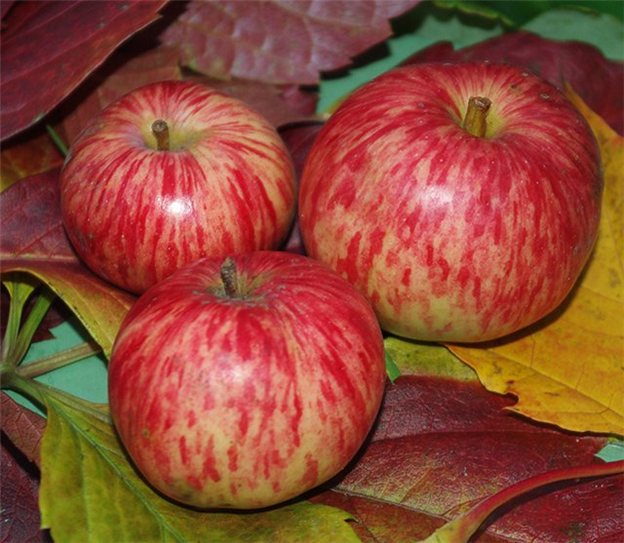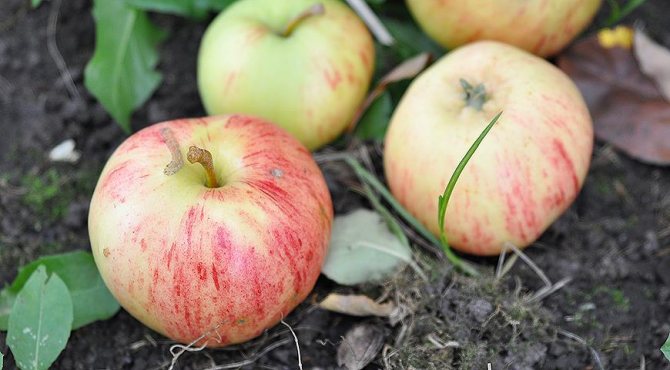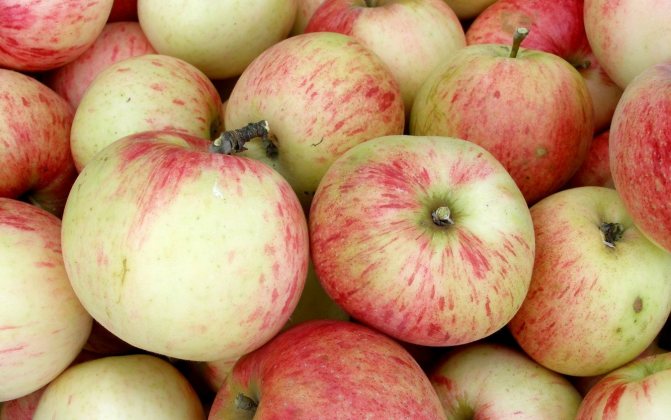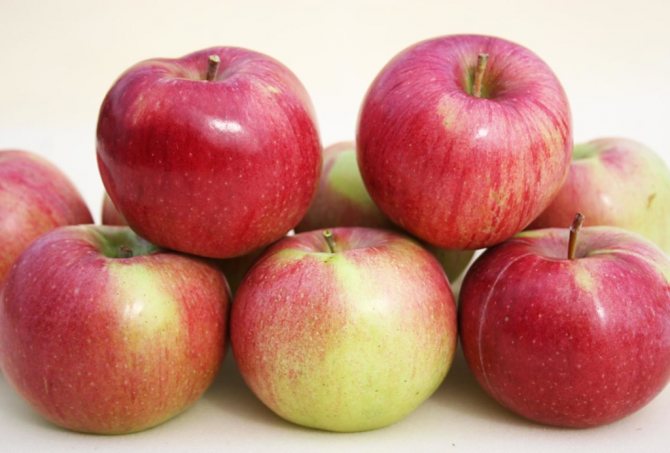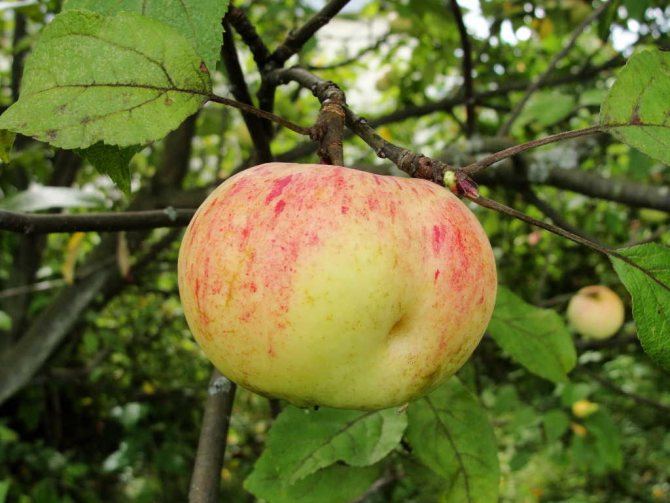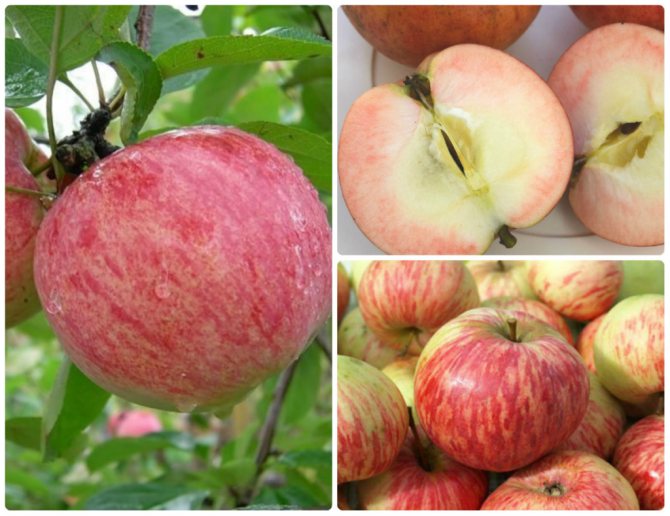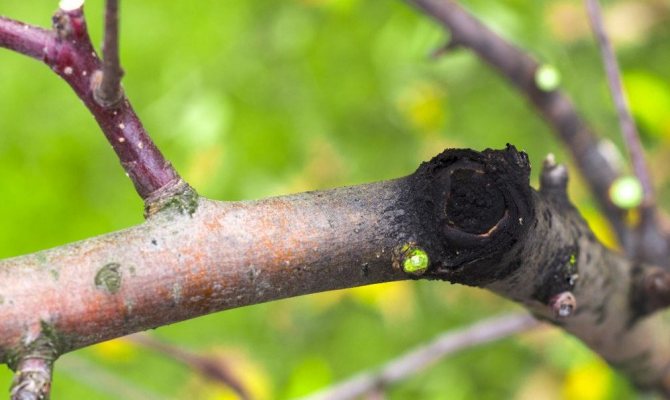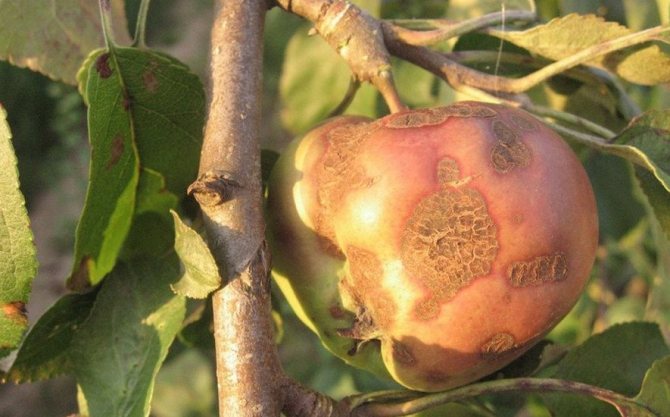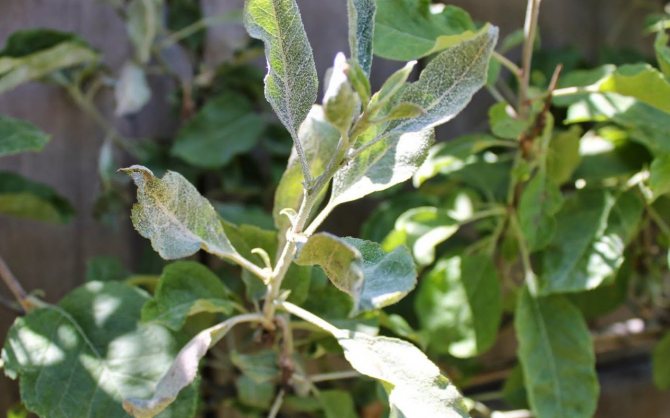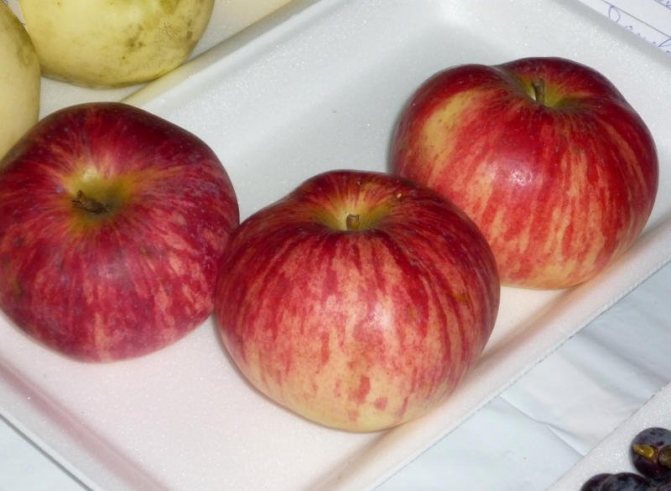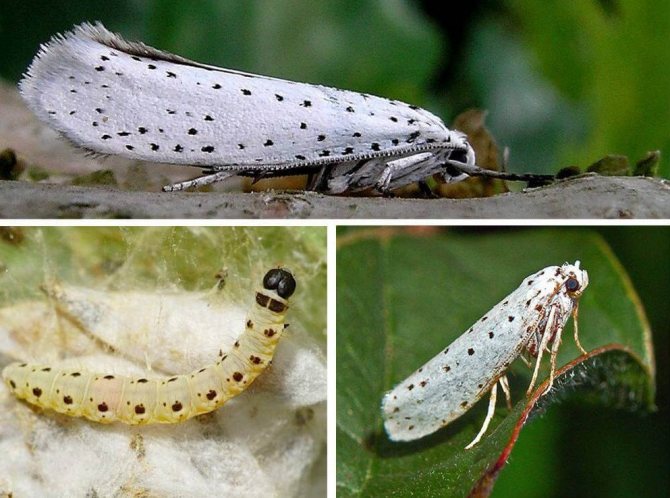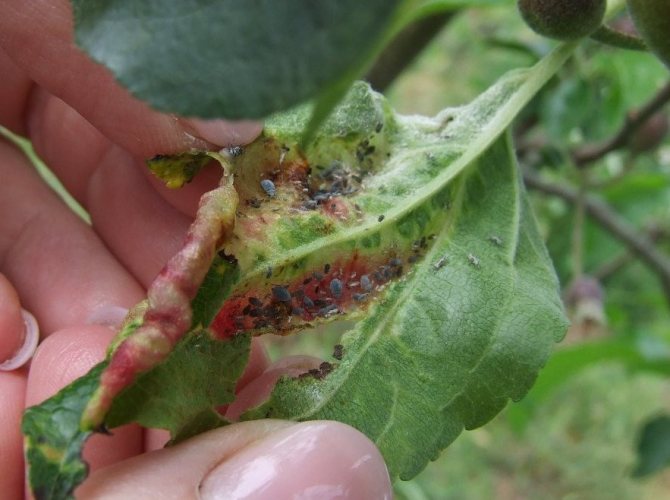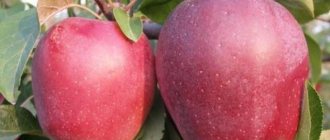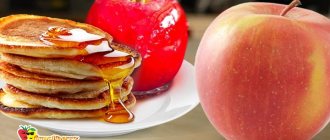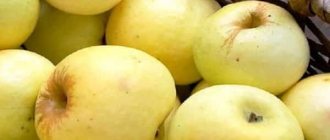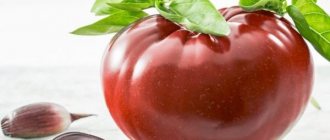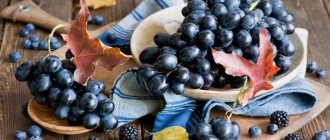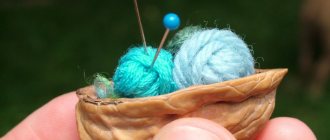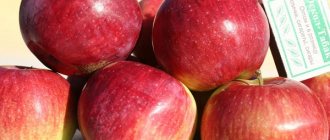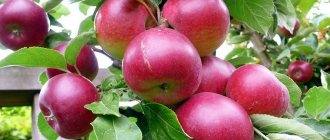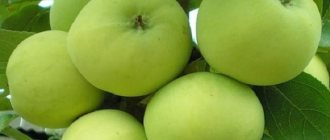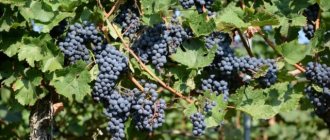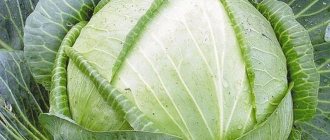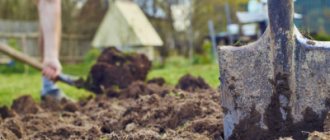This ancient apple variety is the result of natural selection over 200 years ago.
In 1810, it was first described by V.A.Levshin in his recommendations to agrarians and farmers.
Since then, the variety has not changed or improved artificially, but actively crossed with other apple trees and gave life to more than 15 varieties modern apple trees.
Another name for this variety is Brown, Brown and Brown. He got his name thanks to the light, pleasant aftertaste of cinnamon near a ripe apple.
Thanks to exceptional winter hardiness Apple Cinnamon Striped is included in the State Register for the Northern, North-Western, Central Black Earth, Volga-Vyatka and Middle Volga regions.
Apple Cinnamon Striped Description
For high-quality pollination of Cinnamon, the neighborhood of suitable pollinators is necessary, since the variety is self-fertile. The yield of this variety will be favorably affected by the neighborhood with the apiary. Pollination by bees will surely double the yield. The variety is considered to be early maturing, and apples begin to be picked already in early September. You can store them only for 2, maximum - 3 months.
The tree is powerful and quite tall. The crown of the newly planted seedlings is pyramidal, later on it acquires a rounded shape. New shoots have a fine structure. There are absolutely no leaves at the base on the branches, they grow closer to the edges. The same applies to fruits. Leaves are green, narrow, long. The upper side is slightly rough. The flowers are white-pink and smell very nice. This attracts bees and other insects, which are beneficial for pollination and increasing yields.
A striking distinctive feature of this variety is the extraordinary beauty of apples. The ripe apple is yellow, with active red blotches. The fruits are round and smooth. They usually weigh about 90 grams, but in some cases, the weight of a ripe fruit can reach 140 grams. The pulp is juicy, dense and very juicy, yellow in color, has a pink tint under the skin. The taste of the fruit is sweet with a slightly sour taste. Another feature of Cinnamon is a spicy flavor, and Cinnamon owes its name to it.
Varieties of varieties
Cinnamon New was bred by crossing Brown Stripes and Welsey. The fruits turned out to be larger in size and late fruiting. At the end of September, an apple plucked separately can reach 130 grams, it will lie, without spoiling, all winter.
The characteristics of the variety have improved:
- Increased immunity to scab and fungal infection.
- Preserved resistance to frost.
Pineapple retained its resistance to cold, but bears fruit only after a year. The fruits increased to 180 grams, a pineapple flavor appeared, which was the reason for scientists to call the variety Pineapple. The pulp has become more tender and graininess has increased.
At the same time, keeping quality has decreased - apples are not stored for a long time. When ripe, it is better to pluck them and immediately eat them or make preparations. If you leave apples on the branches, then the taste will decrease.
Smokytoye (Sizoye) is another variety obtained from Striped. It differs from the mother plant in a light matte coating that covers the blush. The photo shows the difference in the appearance of the varieties. Smoky retained the properties of the Striped.
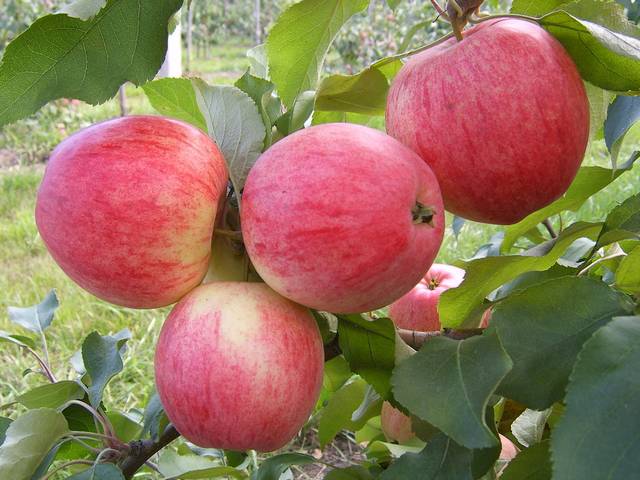

Main characteristics
This variety has its own advantages:
- In our latitudes, there are not so many apple trees that can seriously withstand severe frosts. Cinnamon striped is one of them, it has remarkable resistance to low temperatures, and this is one of its main advantages. Even if it is very cold outside, you don't have to worry about apple trees - they will definitely survive the most severe frosts.
- The apples are very tasty - and this is another pronounced plus. Their taste is unusual, there is simply no other like that. These apples will sell very well and are perfect for home use.
- Another plus is the ability to quickly adapt to all climatic zones. The variety adapts to all conditions, while its yield does not decrease at all.
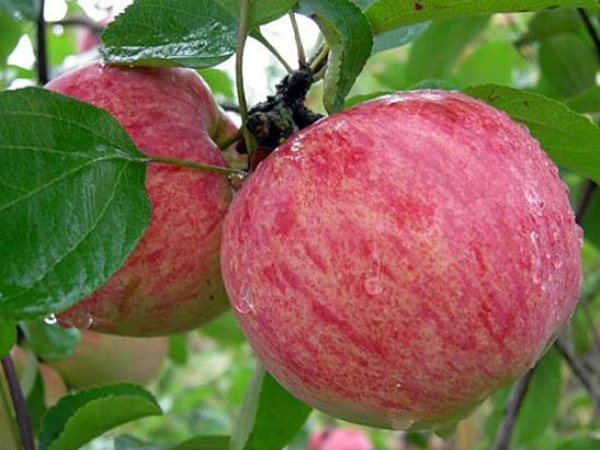

But it would be wrong to think that Cinnamon striped has no flaws at all, they are, and about them below:
- The yield is not that good. If we compare this variety with Antonovka, then it loses to her by half.
- When the apple tree is just beginning to bear fruit, there are even fewer fruits on it, and the fruiting itself begins only in the seventh year after planting.
- The fruits collected from the ground cannot be stored, since they have a very delicate structure, and they will surely break. Only the fruits removed from the branch can be stored for up to three months.
- Trees often get scab.
- The wood of this variety is very prickly, so the branches and the trunk itself can easily break off even during the most severe hurricane.
Testimonials
Tatiana, Samara. The apples have a wonderful taste, they are moderately sweet and juicy, without mealy like that of White Naliv. Even my fussy little daughter loves them! I also like that the tree is not sick with anything and is unpretentious in care... It is a pity that it does not bear fruit every year - after the harvest season, the next apple tree “rests”.
Vasily Ivanovich T. Moscow region. I grow in the country 7 varieties of apple trees and Cinnamon Striped too. I wanted to know, and not just study the description, photos, reviews. Apples are good, no doubt, but the tree itself has disadvantages:
- The main skeletal branches grow downward and under the weight of the crop can break off the trunk. We have to put props under them.
- It's a long time to wait for the harvest - I waited for the first apple for 5 years from the year of planting, and for another 5 years the tree was gaining strength.
But advantages of the variety also have:
- Flower buds are not damaged by frost, and if Melba and Idared can freeze and not give a crop, then Cinnamon always bears fruit.
You just need to look after. Water, fertilize on time.
Irina V, Rostov-on-Don. Cinnamon Striped the most delicious jam... The harvest is enough for our family of 5 people. I sell the surplus like a lot from the dacha. Or I make juice. The apples are dense, do not break during transportation and are beautiful. The variety was planted by my parents, tk. somehow we found a description, a photo and liked it very much. This apple tree is the largest tree on the site.
Disembarkation
You need to plant an apple tree only at a certain time, April or September will be ideal in this sense. Of course, this parameter will depend on the region where the seedling is planted. In the southern latitudes of our country this spring, this apple tree can be planted 15 days earlier than the designated date, and in the fall - 15 later. As for the northern latitudes, planting there in the spring can be done 15 days later, and in the fall - 15 days earlier.
It is better to plant seedlings in a bright, well-ventilated area. Cinnamon does not tolerate shade, in such conditions the yield will definitely be reduced. The soil must be drained; in the first months of growth, the tree must be well-watered. The presence of high groundwater is undesirable, as this can reduce the yield several times or even completely destroy the tree. If the groundwater is high on your site, then the seedlings should be planted on a mound.


The planting hole should match the size of the roots. Deepening of the root collar is not allowed.The soil must be loosened, as the roots need air. For planting, loam or black earth is best suited. Planting on sandy soil is also possible, but in this case additional application of organic fertilizers will be necessary.
As fertilizer, you can use horse humus, which is mixed with humus. This mixture is laid in a hole, after which it is half-filled in this way and compacted. Then a seedling is laid, and the hole is completely filled up. The soil is poured until a mound is formed, which will settle over time. After planting, the tree is abundantly watered with ten liters of water.
Landing rules
The cultivation of this crop is practically no different from the rules for planting and caring for other early autumn varieties of apple trees. The main thing is to choose high-quality planting material, a good place for planting and soil.
Timing
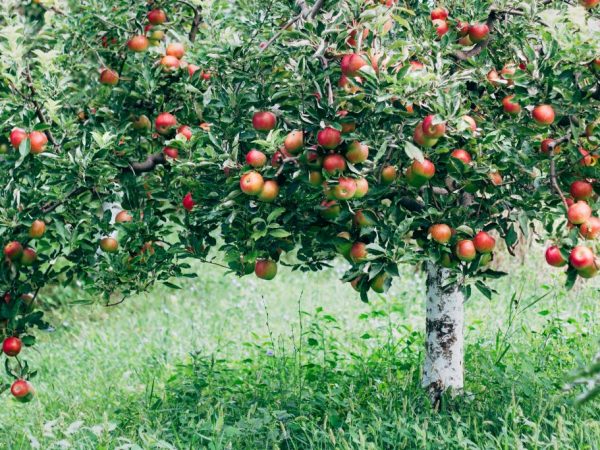

Landing preferably in the fall
You can plant this tree in the spring - in the second or third decade of April, when the earth warms up well and the above-zero temperature stabilizes.
Some gardeners prefer autumn planting - from mid-September to early October. So the seedling has time to adapt and take root 1.5-2 months before the onset of stable frosts.
The advantage of planting in autumn is that apple trees take root faster in moist soil, saturate the required amount of nutrients and undergo good hardening during the winter. With the arrival of spring, they begin to develop actively without interfering with the natural vegetation process.
Place and soil
To grow an apple tree, several conditions must be provided:
- the best place is the south, south-west or south-east side of the garden;
- groundwater depth - 3 m;
- soil with a neutral level of acidity (5-6 units), if the indicator is higher, it is necessary to add a deoxidizer (dolomite flour, slaked lime, chalk or calcite - 400 g per 1 m²);
- loamy or sandy loam soil with a high nutrient content.
A month before planting, all last year's garbage is removed on the site, deep digging is carried out, leveling and processing with a solution of copper sulfate in order to destroy all pathogenic microflora.
Seedling preparation
You can purchase planting material at a gardening nursery or a specialized store. Choose apple trees in an earthen coma or planted in containers - their root system is protected from drying out, so they will successfully transfer the transplanting procedure to the site.
Buy grown seedlings, aged 1-2 years, 70-80 cm high. They have a well-developed aboveground and underground part.
When buying, carefully inspect the crown - the branches should be solid, elastic, without mechanical injuries and signs of infection with diseases. Leaves and buds are juicy, saturated green, do not crumble when shaken off, do not contain yellow, black spots and dry fragments.
Before planting, the plant is removed from the container - immersed in cold water for 10 hours, after adding one of the root growth stimulants. Then they are treated with a clay mash.
Landing technology
Two weeks before the planned landing, holes are dug so that during this time the embedded components have time to settle. The optimal distance between them is 4 m, in a row - 3.5 m.
The dimensions should exceed the volume of the rhizome by 2 times, the approximate parameters are 80x70 cm. A peg is driven into each hole in order to provide it with further support and protection from breaking off by the wind.
Stages:
- a я pit is filled with drainage - pebbles are mixed with crushed stone and screenings;
- a nutrient mixture is laid half the depth - a bucket of dug earth is mixed with 5 kg of compost (humus), 3 kg of peat, a glass of wood ash, 50 g of superphosphate and 45 g of potassium sulfate;
- sprinkle on top with a thin layer of ordinary soil to prevent burning of the roots;
- form a mound, lower a seedling on it so that the root collar is on the surface of the soil;
- fill up all the voids with a fertile composition, trample in the near-trunk zone;
- watered through the holes - water consumption for one plant is 20 liters;
- so that moisture does not evaporate quickly, mulch with a thick layer of peat or sheet compost;
- tied up with a rope or twine to a support.
Pruning
Cropping is also very important. The quality of the future harvest and the resistance of the apple tree to diseases will largely depend on it. At a young tree, the branches are cut by a third. So the crown will develop faster and better. Pruning is best done in mid-spring, before bud break. If the branches bent to the very ground, then they must be cut off, despite the presence of fruits on them.
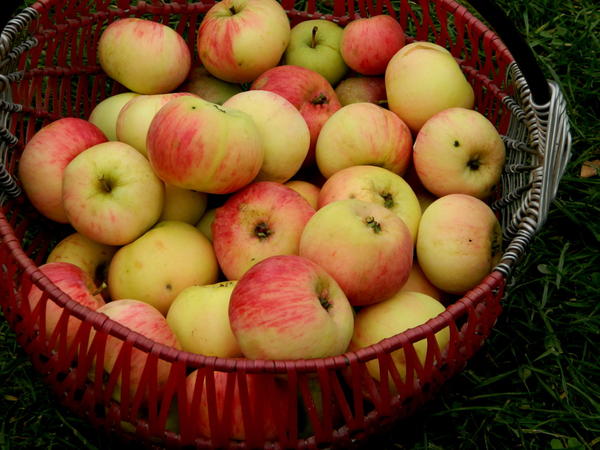

As a protective measure, thinning of the branches is carried out. This will protect the apple tree from some diseases, as well as from pests. You don't need to remove strong branches, but you definitely need to get rid of tops. You should cut off no more than 1/4 of the crown.
Harvesting and storage
The period of fruit ripening begins at the end of August, at which time you can already start harvesting. It is better to pick the fruits on a warm, dry day, so that the apples are not wet and are better stored. The fruits should be plucked, without separating from the stalks, carefully so as not to damage the peel. The harvest is best stored in wooden or fruit boxes in a cool room, at a temperature of 2 to 5 ° C and an air humidity of no higher than 70%.
Transportability, subject to proper storage, is good, thanks to the dense skin, the pulp of apples is not injured, the appearance is preserved.
Thus, the Cinnamon striped variety is popular for cultivation at home, as it has a stable yield and excellent fruit taste. To make the growing process as simple and effective as possible, it is recommended to take into account the recommendations that are described in detail in the article.
Watering
Watering this variety of apple trees is necessary once a week. Watering is done in the morning and in the evening. At least 10 liters of water must be used for each tree. In the middle of summer, processes that directly affect the formation of the crop begin to occur in apple trees, therefore trees need watering at this time of the year.
If there is not enough moisture, it will negatively affect the harvest of the current and even the next year. It is necessary to water the trees at least until August.
Breeding history
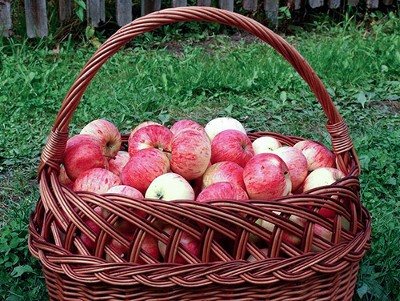

Cinnamon Striped is an old apple variety, the exact name of its inventor is unknown.
Most likely, no one took him out on purpose, the variety appeared naturally, thanks to natural processes, primarily cross-pollination.
The first mentions of the Cinnamon Stripe date back to the nineteenth century. Information about this apple variety can be found in popular gardening books, dated 1810.
However, scientists believe that the actual age of the Cinnamon Apple is much more impressive, and that this the variety appeared long before the nineteenth century.
The cinnamon striped apple was repeatedly mentioned in his stories by A.P. Chekhov. And in the estate of Leo Tolstoy, Yasnaya Polyana, according to rumors, there was a whole huge garden of Cinnamon apples.
In a word, this variety of fruit trees in our country has a special meaning and is a favorite for many gardeners.
Diseases
Scab
Leaves that have fallen from a tree affected by scab must be burned. In the spring, the tree must be treated with a urea solution (7%).
Root cancer
Young apple trees usually suffer from this disease. In this case, it is necessary to cut off all growths and wounds and treat them with copper sulfate (1%).
Cytosporosis
In this case, 1% copper sulfate is also used, it is added to lime, which whitewashes the lower part of the tree trunk. Sick branches should be burned, and the wounds should be treated with garden varnish.
Plant care rules
Cinnamon striped does not need special care. Emphasize the pruning and preventive treatments of Brown. The apple tree is susceptible to pests, phyto-diseases. Top dressing for plantings is applied in the spring - mainly nitrogen, phosphorus and potassium - in the fall to protect strength and winter. Don't forget about watering. To facilitate care, mulch is added to the soil under Cinnamon: compost or dry mullein.
Karish needs competent pruning. When planting an apple tree, the branches of the Cinnamon striped are cut to 1/3 of the length. Every year, tops are removed, branches descending to the ground, thinned shoots are thinned out.
Spring is optimal for the operation, until the buds bloom. If the manipulation falls in the fall, they wait for the apple tree to shed its foliage and go to sleep. To prevent infection, the cuts are treated with garden pitch.
Features of fruiting
Cinnamon apple, what kind? This variety belongs to self-fertile apple trees, that is, it needs pollinators for fruiting.
The best pollinators are:
- Paping,
- Moscow pear tree.
But any other varieties of apple trees that bloom at the same time as the Cinnamon Striped variety will do. It is not necessary to plant these apple trees nearby.
It is enough that they grow at a distance of 50-70 meters.
Fruit
- Medium size, 90-110 gr. Flattened in shape. See photo and description of the variety.
- They look like turnips, smooth, without ribbing.
- The apple itself is yellow-green in color with purple-red stripes.
- The pulp is dense, juicy, yellow or pinkish in color.
- The taste is sweet with a pleasant sourness and light cinnamon aftertaste.
- The sugar content is 10% and 0.5% acid.
By the term of fruit ripening, the Cinnamon Striped variety belongs to the early autumn. It begins at the end of August in the southern regions, and in mid-September in the northern ones.

